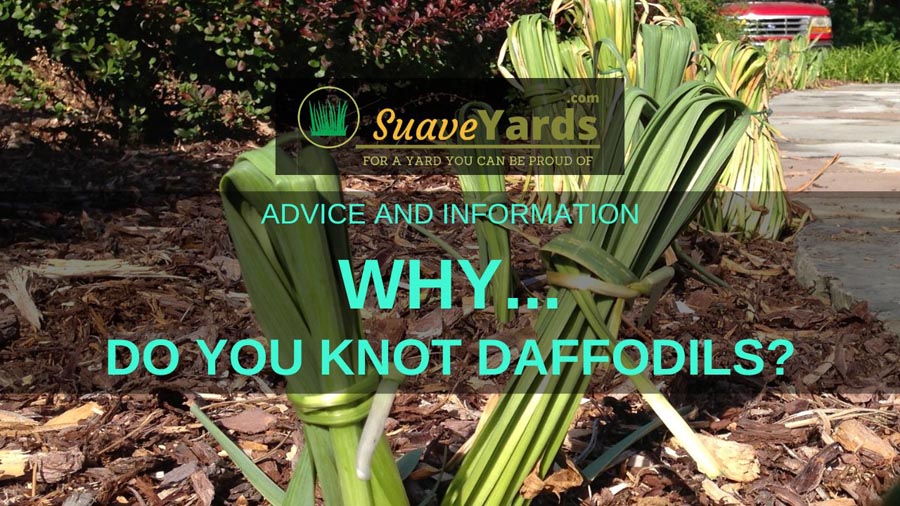
Have you ever walked past someone’s garden and seen their daffodils neatly tied together or folded over?
If you have you might have had the urge to ask them ‘why do you knot daffodils?’
It was a tradition that was once very popular but now isn’t as much so.
But what is the purpose of knotting or tying off daffodils?
We will take a look at it in this blog.
So let’s get started.
Why Do You Knot Daffodils?
Knotting daffodils is something that was popular in generations gone by to tidy up an unruly mess of daffodils that have flowered, but not died down. Whilst it might make your garden look neater, it is bad for the daffodil. It reduces the surface area of its leaves, meaning they can absorb less sunlight and can’t properly replenish the bulb ready to successfully grow again the following year.
So, Why Knot Daffodils?
Knotting or tying up daffodils is something your parents; or grandparents’ generations might have done with frequency.
The idea behind it is an aesthetical one, not a horticultural one.
It is done simply to tidy up daffodils after they have flowered and are dying down.
Once the blooming season of a daffodil is over the long leaves discolor and became unruly, collapsing and getting in the way of things.
You can’t cut them off because the leaves play a vital role in storing energy and enabling the daffodil to flower the next year.
So some gardeners would (and still do), fold them over/tuck them in/braid them together or tie them up.
The result is a much tidier and nicer-looking flower bed.
RELATED ===> Why Do Daffodils Grow In Random Places?
How Do You Knot Daffodils?
Quite simply you don’t.
Or really you shouldn’t.
This once common occurrence is now rarely seen.
And there is a reason for this.
It isn’t good for your daffodils.
The leaves of a daffodil are hugely important.
Even when you might think they are not doing anything, they are absorbing sunlight and nutrients and feeding the bulb so it can have happy and healthy blooms the following year.
If you tie the leaves together, fold them over or braid them you are reducing the surface area of the leaves than can absorb sunlight.
This means fewer nutrients for the bulb and an increased chance of daffodil blindness the following year.
Knotting the leaves of a daffodil also restricts the flow of sap which can cause bulbs to suffer.
On top of that knotting or braiding the foliage of a daffodil is also a time-consuming process!
RELATED ===> Why Do Daffodils Bend Over?
I know there are still some people who knot their daffodils after they have flowered, and undoubtedly there will be many of those people who say it has never stopped their daffodils blooming again the next year.
But I prefer to listen to the advice of renowned British gardener Monty Don, who says on the subject:
“You should resist any temptation to cut back, tie up or ‘tidy up’’ the foliage of any bulbs that have finished flowering as this will decrease the quality of flowering next spring.”
So What Can You Do?

My own personal advice is to simply wait it out and put up with a messy-looking garden for a few weeks.
Once your daffodils have stopped blooming it can take a couple of months for them to completely die down.
The leaves will yellow, and then gradually become dry and brown, usually after 6 to 8 weeks.
Only then can you remove them. They should easily come off of the bulb with a gentle pull.
Or if you really want to tidy up your spring bulbs, then Monty Don has a simple solution.
Remove the bulbs, foliage and roots completely from the ground and pot them into a container.
Move that container to a sunny spot and let the daffodils die back naturally, without being in a prime position in your garden. Then just replant in the autumn.
Monty Don reaffirms the fact the spring bulbs are tough and can be dug up and replanted numerous times. As long as the bulbs don’t become too wet when they are in the container then they will be fine.
RELATED ===> Can You Keep Daffodils In The Fridge?
Final Thoughts
If you have a number of spring bulbs, like daffodils, in your garden you will be totally familiar there is that awkward period of limbo where your flowers have stopped blooming but haven’t completely died back.
As desperate as you might be to tidy up your garden at this point, you should resist tying up your daffodils.
Doing so will increase the chances of them not flowering the following year. The knotted foliage will not be able to properly absorb sunlight to replenish the bulb satisfactorily.
So when you ask people ‘why do you knot daffodils’? They probably do it with the very best intentions, but don’t realise those intentions are unfortunately misguided.
